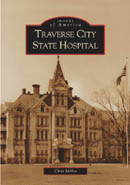Arcadia Publishing

Arcadia Publishing is best known for its iconic Images of America series, which chronicles the history of small towns, events, and specific topics across the country. Arcadia is home to a growing number to asylum related books, written by various authors. Below is a list of available asylum books from this publisher.
Contents
- 1 Byberry State Hospital
- 2 Danvers State Hospital
- 3 Dixmont State Hospital
- 4 Eloise: Poorhouse, Farm, Asylum and Hospital 1839-1984
- 5 Essex County Overbrook Hospital
- 6 Essex Mountain Sanatorium
- 7 Greystone Park Psychiatric Hospital
- 8 Harrisburg State Hospital
- 9 Hudson River State Hospital
- 10 Napa State Hospital
- 11 Northampton State Hospital
- 12 Norwich State Hospital
- 13 Oakdale: The Lapeer State Home
- 14 Oregon Asylum
- 15 Pennhurst State School and Hospital
- 16 Spring Grove State Hospital
- 17 Traverse City State Hospital
Byberry State Hospital[edit]

Author(s):Hannah Karena Jones
ISBN:9780738599083
On Sale Date:05/20/2013
Purchase this book on Amazon
Book Description: Looming on the outskirts of Philadelphia County since 1906, the mental hospital most commonly known as "Byberry" stood abandoned for 16 years before being demolished in 2006. At its peak in the 1960s, Byberry was home to more than 6,000 patients and employer to more than 800. With its own self-sustaining farm, bowling alleys, barbershop, ice cream parlor, federal post office, and baseball team, Byberry was a micro-community. Throughout its history, the hospital served as an educational institution for Philadelphia's medical, nursing, and psychology students; was the site of a World War II Civilian Public Service conscientious objector unit; and a volunteering hot spot for local churches, schools, and Girl and Boy Scout troops. This book provides an unprecedented window into the good, the bad, the unusual, and the forgotten history of Byberry.
Author Bio: Hannah Karena Jones holds dual bachelor's degrees in history and creative writing from Bloomsburg University of Pennsylvania and has presented her historical research at national Phi Alpha Theta and Collegiate Honors Council conferences. The images in this collection come from the Swarthmore College Peace Collection, Philadelphia City Archives, Pennsylvania State Archives, the Special Collections Research Center of the Temple University Libraries, the Library Company of Philadelphia, PhillyHistory.org, the Historical Society of Pennsylvania, and the personal collections of former staff members, among others.
Danvers State Hospital[edit]

Author(s):Kate Anderson, Robert Duffy, Introduction: John Archer
ISBN:9781467127660
On Sale Date:02/26/2018
Purchase this book on Amazon
Book Description: Perched high on the top of Hathorne Hill in what was once the village of Salem, Danvers State Insane Asylum was, for more than a century, a monument to modern psychiatry and the myriad advances in mental health treatment. From the time it opened its doors in 1878 until they were shuttered for good in 1992, the asylum represented decades of reform, the physical embodiment of the heroic visions of Dorothea Dix and Thomas Story Kirkbride. It would stand abandoned until 2005, when demolition began. Along with a dedicated group of private citizens, the Danvers Historical Society fought to preserve the Kirkbride structure, an effort that would result in the reuse of the administration building and two additional wings. Danvers has earned a unique place in history; the shell of the original Kirkbride building still stands overlooking the town. Though it has been changed drastically, the asylum's story continues as do efforts to memorialize it.
Author Bio: Katherine Anderson and Robert Duffy have spent the past decade documenting asylums in both print and media, working to continue the legacy of Dr. Kirkbride and the many men and women who lived and worked at Danvers State Hospital.
Dixmont State Hospital[edit]

Author(s): Mark Berton
ISBN: 9780738545202
On Sale Date: 09/11/2006
Purchase this book on Amazon
Book Description: Pittsburgh natives have recognized Dixmont State Hospital by its towering boiler house smokestack that stood prominently along busy Route 65. It has been a topic of curiosity, urban exploration, ghost hunts, and historical research; but prior to its closing in 1984, Dixmont State Hospital stood as a refuge to the mentally ill for three counties in western Pennsylvania. A majestic study in the Kirkbride design of asylum architecture, Dixmont was originally built by the Western Pennsylvania Hospital in 1859 as a private venture before being bought by the commonwealth. It was named for famed mental health care reformer Dorothea Dix, who was instrumental in choosing the hospital’s site—a site chosen for its tranquility and its view of the Ohio River. Dixmont was completely razed in January 2006 to make way for a multi-parcel commercial endeavor. But for those who spent time there, Dixmont was a vibrant community within a community. Through historic photographs, Dixmont State Hospital opens up this world that was off limits to the general public but was alive with festivals, celebrations, and the successful treatment of patients.
Author Bio: Mark Berton covered Dixmont State Hospital for several years during his tenure with the Pittsburgh Tribune-Review, and he spends his free time photographing asylum architecture. His access to Dixmont and those who were part of its history provided a unique perspective in the life of a functioning mental health facility and its demise.
Eloise: Poorhouse, Farm, Asylum and Hospital 1839-1984[edit]

Author(s): Patricia Ibbotson
ISBN: 9780738519548
On Sale Date: 06/02/2002
Purchase this book on Amazon
Book Description: Eloise, which started out as a poorhouse, later became known as Wayne County General Hospital. From only 35 residents on 280 acres in 1839, the complex grew dramatically after the Civil War until the total land involved was 902 acres and the total number of patients was about 10,000. Today, all that remains are five buildings and a smokestack. Only one of them, the Kay Beard Building, is currently used. In Eloise: Poorhouse, Farm, Asylum, and Hospital, 1839-1984, this institution and medical center that cared for thousands of people over the years, is brought back to life. The book, in over 220 historic photographs, follows the facility's roots, from its beginnings as a poorhouse, to the founding of its psychiatric division and general hospital. The reader will also be able to trace the changing face of psychiatric care over the years. The book effectively captures what it was like to live, work, and play on Eloise's expansive grounds.
Author Bio: The author, Patricia Ibbotson, is a nurse, who worked at Eloise for over 23 years. She currently sits on the board of the Friends of Eloise, and she has been the editor of the Detroit Society for Genealogical Research Magazine for seven years.
Essex County Overbrook Hospital[edit]

Author(s): Kevin R. Kowalick, and Kathryn Cataldo, and Forward: Edward L. Williams
ISBN: 9781467127257
On Sale Date: 11/03/2017
Purchase this book on Amazon
Book Description: What was founded as the Essex County Lunacy Asylum evolved from a single building on South Orange Avenue to a city within itself in Cedar Grove. It was named the Essex County Overbrook Hospital. Construction began on the hospital's iconic brick buildings in 1896, and they were prominent features on Fairview Avenue for the next 100 years. The facility produced its own food, housed its own police and fire departments, and sustained its own power sources. The Essex County Overbrook Hospital was recognized throughout the world as a leader in psychiatric care. In later years, overcrowding began to plague the institution. However, after the advent of modern psychiatric drugs, many patients were able to be discharged back into the community. In 2007, the buildings were closed, and the hospital was relocated to a newer establishment nearby. The grounds have since been plagued with vandalism and neglect, with a final deal for demolition having been solidified in 2015.
Author Bio: Author Kevin R. Kowalick, photographer and historical preservationist, has had a particular fascination with the hospital for many years. He has spent those years researching and documenting the historical facility. Coauthor Kathryn Cataldo has worked with numerous media outlets to gain historical recognition for this facility and other similar institutions.
Essex Mountain Sanatorium[edit]

Author(s): Richard A. Kennedy
ISBN:9780738599441
On Sale Date:08/01/2013
Purchase this book on Amazon
Book Description: Perched high on the top of Hathorne Hill in what was once the village of Salem, Danvers State Insane Asylum was, for more than a century, a monument to modern psychiatry and the myriad advances in mental health treatment. From the time it opened its doors in 1878 until they were shuttered for good in 1992, the asylum represented decades of reform, the physical embodiment of the heroic visions of Dorothea Dix and Thomas Story Kirkbride. It would stand abandoned until 2005, when demolition began. Along with a dedicated group of private citizens, the Danvers Historical Society fought to preserve the Kirkbride structure, an effort that would result in the reuse of the administration building and two additional wings. Danvers has earned a unique place in history; the shell of the original Kirkbride building still stands overlooking the town. Though it has been changed drastically, the asylum's story continues as do efforts to memorialize it.
Author Bio: Author Richard A Kennedy, an amateur historian and past explorer of Essex Mountain Sanatorium, has amassed a collection of photographs culled from libraries, historical societies, and private collections to pay a final, lasting tribute to this once grand institution, which is now lost to time.
Greystone Park Psychiatric Hospital[edit]

Author(s):Rusty Tagliareni and Christina Matthews, Introduction: Robert Kirkbride
ISBN:9781467116497
On Sale Date:07/11/2016
Purchase this book on Amazon
Book Description: Founded in 1907 amidst protests and a burgeoning suffrage movement, Essex Mountain Sanatorium was the result of two Montclair, New Jersey, women who successfully lobbied local government to establish a tuberculosis sanatorium in a then vacant cottage for wayward girls. From these humble beginnings, the hospital grew to become one of the finest treatment centers in the nation, expanding into a complex of 20 buildings that encompassed nearly 300 acres. Ironically, medical advances pioneered at places such as the sanatorium and the advent of antitubercular drugs in the years following World War II led to decreasing patient enrollment, which made such large facilities unnecessary. When it was eventually abandoned in the early 1980s, the hospital began its second act as a haven for urban explorers, vandals, and arsonists, becoming shrouded in mystery and the source of local legends and myths. After suffering years of neglect and abuse, the main complex would finally fall to wreckers in 1993, ending an important era in county, state, and national history.
Author Bio: Rusty Tagliareni and Christina Mathews joined Greystone preservation efforts in early 2013. They quickly became public supporters of the rehabilitation of the venerable old asylum and spoke publicly on topics ranging from the viability of reuse to the controversy surrounding numerous rejected rehabilitation proposals. In 2015, they brought Greystone to a national stage when they presented at the PreservationWorks national Historic Asylum Preservation Conference.
Harrisburg State Hospital[edit]

Author(s): Phillip N. Thomas
ISBN: 9780738598277
On Sale Date: 03/11/2013
Purchase this book on Amazon
Book Description: Harrisburg State Hospital opened in 1851 as the Pennsylvania State Lunatic Hospital, the first public institution in the state. Situated atop a hill overlooking the Susquehanna River, the original building was an early example of a Kirkbride design hospital. The facility closed in 2006 after serving the commonwealth for 155 years. Harrisburg State Hospital: Pennsylvania's First Public Asylum presents a pictorial history of the hospital from the first year of only 12 patients through the peak of state care, when the population reached over 2,500 in the 1950s. Harrisburg State Hospital was an innovative leader in the treatment of the mentally ill, pioneering new methods of therapy even before they were common practice. It was a community and a home for those whom society could not otherwise care for.
Author Bio: Phillip N. Thomas discovered Harrisburg State Hospital in 2007 after taking up a hobby photographing abandoned buildings. After his visit, he would go on to create a website dedicated to the hospital, doing the same two years later for the state hospital in Danville. This book is his culmination of five years of research into the history of Harrisburg State Hospital.
Hudson River State Hospital[edit]

Author(s): Joseph Galante, Lynn Rightmyer, and Hudson River State Hospital Nurses Alumni Association
ISBN: 9781467129695
On Sale Date: 08/06/2018
Purchase this book on Amazon
Book Description: For 141 years, Hudson River State Hospital was home to tens of thousands of individuals suffering from mental illness. The facility grew from a 208-acre parcel in 1871 with seven patients to 752 acres with five dozen separate buildings containing nearly 6,000 patients in 1954. The main building was constructed on a Kirkbride plan, a treating philosophy centered around an ornate building of equal proportions staffed by employees who integrated dignity and compassion into health care. Famous architects Frederick Clark Withers and Calvert Vaux drafted the main building in 1869. The landscape was penned by Frederick Law Olmstead, perhaps best known for the design of New York City's Central Park.
Author Bio: Historian Joseph Galante is a former state hospital staffer and current graduate student of mental health studies at Hofstra University on Long Island, New York. Lynn Rightmyer is a registered nurse and graduate of Hudson River's nursing school, class of 1975. Out of Rightmyer's 43-year tenure as a nurse, 19 years were spent on the wards at Hudson River. Both Rightmyer and Galante are history curators with the Hudson River State Hospital Nurses Alumni Association (HRSHNAA), from which many of the archival images in this book appear.
Napa State Hospital[edit]

Author(s): Patricia Prestinary
ISBN: 9781467131995
On Sale Date: 09/08/2014
Purchase this book on Amazon
Book Description: Napa, because of its natural beauty and optimal conditions for moral treatment, was chosen as the second site for a state hospital to ease overcrowding in Stockton Asylum. When the fully self-sustaining Napa Asylum opened in 1875, it quickly filled to capacity and became home to many people suffering from mental illness, alcoholism, grief, and depression. In 1924, Napa Asylum was renamed Napa State Hospital to reflect changes in the medical model and treatments for psychiatric patients. Covering the first 100 years of the hospitals history, this unique book tells the story of the institution and the people for whom it served as employer. Known locally as Imola, this beautiful site became an integral part of the community.
Author Bio: Patricia Prestinary is a librarian and archivist who discovered the history of the Napa State Hospital through her volunteer work with the Napa Historical Society and Napap County Landmarks. The images in this collection come from the Napa Historical Society, California State Library, the Napa State Hospital, the Bancroft Library, and the personal collections of former staff members, amoung others.
Northampton State Hospital[edit]

Author(s): J. Michael Moore and Anna Schuleit Haber
ISBN: 9781467122269
On Sale Date: 10/27/2014
Purchase this book on Amazon
Book Description: Northampton State Hospital, established in 1856, was built with the optimistic spirit of humanitarian reform. For many years, it was run by Dr. Pliny Earle, a champion of treatment that combined individualized care with manual labor, religious worship, recreation, and amusement. This vision was overwhelmed as the hospital was called upon to care for ever-larger numbers of people with varying needs. By the mid-20th century, the hospital was an isolated small city, with hundreds of employees caring for more than 2,000 patients in overcrowded and inadequate conditions. It became a nationally important center of political and legal struggle over the role of state hospitals in the care of the mentally ill. After being gradually phased out, the hospital was closed in 1993, and the buildings, though listed in the National Register of Historic Places, were demolished in 2006. This volume brings to life the 135-year story of Northampton State Hospital through beautiful and haunting photographs drawn from the collections of Historic Northampton, the citys local history museum.
Author Bio: Historian J. Michael Moore is the author of The Life and Death of Northampton State Hospital, based on extensive interviews with workers and clients. Visual artist Anna Schuleit Haber created the sound installation Habeas Corpus, in which the abandoned architecture was turned into an instrument in a single performance of J.S. Bach's Magnificat.
Norwich State Hospital[edit]

Author(s): Christine M. Rockledge
ISBN: 9781467129626
On Sale Date: 10/15/2018
Purchase this book on Amazon
Book Description: Norwich State Hospital (NSH), established in 1904, was more than just a series of mortar and brick buildings to house and treat persons suffering from mental illness. For nearly 100 years, generations of people dedicated their careers and lives to developing NSH as a humanitarian community for mental illness rehabilitation. NSH gained international attention from some of the world's most renowned psychiatrists for being the first state hospital to boast a brand-new state-of-the-art building to house all occupational therapies under one roof. Although NSH closed in 1996, the structure has continued to be one of Connecticut's most notable historical landmarks, despite its ongoing demolition and redevelopment. Today, Norwich State Hospital is still alive in the timeless, emotional memories employees and family members share of what it was like to work and grow up in a place where employees were not just employees and patients were not just patients; they were family.
Author Bio: Christine M. Rockledge began extensively researching Norwich State Hospital in 2009 and allied with the Preston Historical Society in 2011. She has spoken publicly raising awareness on the importance of Norwich State Hospital's local contribution to mental health and Connecticut history and how it applies today. Many of the images in this book come from former hospital staff and their families and have never been seen before by the public.
Oakdale: The Lapeer State Home[edit]

Author(s): Laura Fromwiller and Jan Gillis
ISBN: 9781467112437
On Sale Date: 08/04/2014
Purchase this book on Amazon
Book Description: The Lapeer State Home has been a large part of the history of Lapeer County since it beginning in 1895. After start with three buildings and housing for 200 patients, the facility grew to encompass several hundred acres and at its peak, accommodating over 4,000 patients. The history of the home includes a variety of memories from staff members, patients, and visitors who once walked its halls. Images of America: Oakdale: The Lapeer State Home provides a journey of this historic institution and attempts to bring some clarity to questions that remain about the home and its past.
Author Bio: Laura Fromweller and Jan Gillis are Lapeer County residents who work at the historic Marquette deAngeli Library in Lapeer and have researched the Lapeer State Home for over 15 years. This book contains a compilation of materials and photographs that the authors have gathered, from community members and other sources, for the library's collection. Fromweller has a master's degree in litrary and information science from Wayne State University, and Gillis has a baccalaureate in communications form the University of Washington.
Oregon Asylum[edit]

Author(s): Diane L. Goeres-Gardner
ISBN: 9780738599885
On Sale Date: 06/17/2013
Purchase this book on Amazon
Book Description: The Oregon State Insane Asylum was opened in Salem on October 23, 1883, and is one of the oldest continuously operated mental hospitals on the West Coast. In 1913, the name was changed to the Oregon State Hospital (OSH). The history of OSH parallels the development and growth in psychiatric knowledge throughout the United States. Oregon was active in the field of electroshock treatments, lobotomies, and eugenics. At one point, in 1959, there were more than 3,600 patients living on the campus. The Oscar-winning movie One Flew Over the Cuckoo's Nest was filmed inside the hospital in 1972. In 2008, the entire campus was added to the National Register of Historic Places, and the state began a $360-million restoration project to bring the hospital to modern standards. The story of OSH is one of intrigue, scandal, recovery, and hope.
Author Bio: Historian J. Michael Moore is the author of The Life and Death of Northampton State Hospital, based on extensive interviews with workers and client. Visual artist Anna Schuleit Haber created the sound installation Habeas Corpus, in which the abandoned architecture was turned into an instrument in a single performance of J. S. Bach's Magniicat.
Pennhurst State School and Hospital[edit]

Author(s): J. Gregory Pirmann and the Pennhurst Memorial & Preservation Alliance
ISBN: 9781467123662
On Sale Date: 06/17/2015
Purchase this book on Amazon
Book Description: For nearly 80 years, Pennhurst State School and Hospital was a reminder of how society viewed and treated people with intellectual disabilities. Over its existence, Pennhurst was home to more than 10,600 people. Many spent decades there, working to keep the institution running by performing various jobs. While some enjoyed the lives they had fashioned for themselves at Pennhurst, for many others, life there was crushing. Pennhurst also played a central role in the lives of its employees and in the rural Pennsylvania community where it was located. Controversy plagued the institution for its entire existence, and it is remembered primarily as a place where bad things happened. However, it was much more than that. This book provides a window into that separate world, reminding those who were part of it of what they saw and did there and giving those who know only what they have heard or seen a different picture of what Pennhurst truly was.
Author Bio: J. Gregory Pirmann worked at Pennhurst from 1969 to 1986, part of a 38-year career in the field. He is one of the founders of the Pennhurst Memorial & Preservation Alliance (PM&PA). The archival images in this book primarily come from reports sent to the legislature by the board of trustees in the first 20 years of Pennhurst's existence. Others have been gathered from a variety of sources, collected over the years by the author.
Spring Grove State Hospital[edit]

Author(s): David S. Helsel M.D., Trevor J. Blank
ISBN: 9780738553269
On Sale Date: 02/25/2008
Purchase this book on Amazon
Book Description: Founded in 1797, Spring Grove State Hospital, now known as Spring Grove Hospital Center, is the second oldest continuously operating state psychiatric hospital in the country. This volume will reveal through a broad array of poignant historic images the extensive, complex, and fascinating history of Maryland’s oldest hospital. Included are interior and exterior photographs of many of the hospital’s historic buildings, as well as depictions of daily life at the hospital during a bygone era. The institution’s historic pedigree includes its role as a hospital for soldiers and sailors wounded in the Battle of North Point during the War of 1812, and Spring Grove’s Main Building may have been used to quarter soldiers during the Civil War. Once a largely self-contained asylum, Spring Grove’s history is closely tied to the crusader Dorothea Dix, as well as to many more recent treatment advances.
Author Bio: Psychiatrist David S. Helsel, M.D., serves as the current superintendent of Spring Grove Hospital Center. Trevor J. Blank is a graduate student at Indiana University’s Folklore Institute and is the founder of the Hillcrest Historical Society, a Baltimore County historic preservation group that worked to save Spring Grove’s former maximum-security building.
Traverse City State Hospital[edit]

Author(s): Chris Miller
ISBN: 9780738533896
On Sale Date: 05/02/2005
Purchase this book on Amazon
Book Description: Northern Michigan Asylum, which opened in 1885, was known during most of its years as Traverse City State Hospital. It was run during its first decades by Dr. James Decker Munson, who left his legacy in the landscaped grounds and the medical center that today bears his name. Traverse City State Hospital served the mental health needs of a large part of Michigan for 104 years until its closure in 1989, housing a population as large as 3,000 in its many buildings.This book traces the history of this great institution, from the local and mental health context in which it was founded, through its growth, development, and decline, and finally to its renovation and preservation as a vital part of the Traverse City community. More than 200 photographs and images are provided, including many of the features and buildings long gone.
Author Bio: Author Chris Miller was active as a member of the Committee to Preserve Building 50, one of the community groups that arose to save the historic and natural features of the former Traverse City State Hospital grounds when they were threatened at the end of the 1990s. He is the author of Winona in Vintage Postcards, also available from Arcadia Publishing.